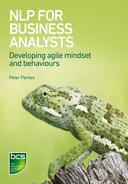Book Description
Method and process are important in business analysis, but knowing how to use them is even more so. As a business analyst you can increase your effectiveness most by developing your soft skills, recognising that finesse can be more effective than force. Once developed, you will find that these skills are transferable across project types and whole industry sectors. This book illustrates the application of NLP to develop competencies - better equipping you to communicate across cultures, reframe problems, manage stakeholder groups, resolve conflicts, motivate teams and become an even better leader.
